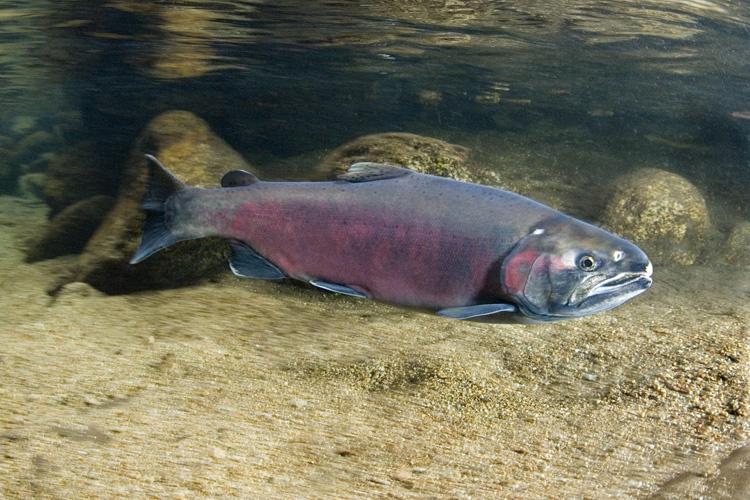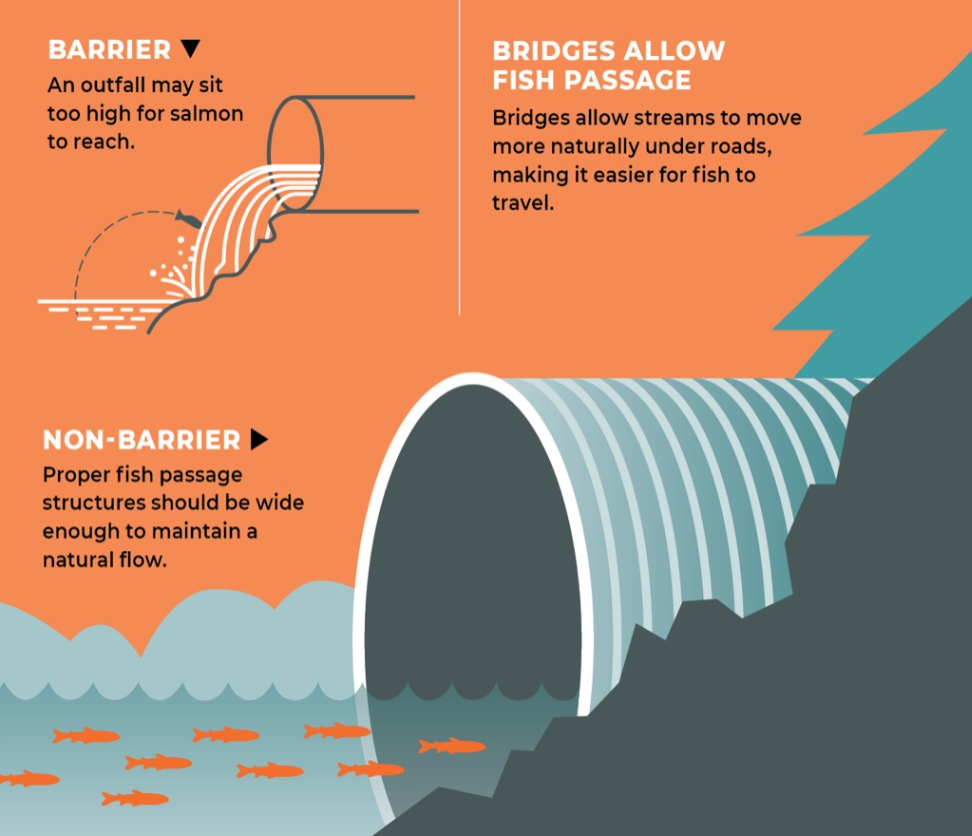One important way to measure the health of salmon species is by counting the number of adult fish that return from the ocean to spawn in their native rivers. Next is to test the water that the Salmon live and spawn in. What are Ideal Water Conditions for Salmon?
Ideal water conditions for salmon include temperatures between 4-18°C, dissolved oxygen levels above 8 mg/L, pH range of 6.5-8.5, clear water with minimal turbidity, moderate flow rates, and balanced nutrient levels. Human interventions like dams and pollution must also be minimized.
Besides water quality, NOAA also considers threats and factors affecting the health of fish including habitat, hydropower, hatchery, and harvest impacts. NOAA’s analysis called the 5-year biological status review, is the method by which NOAA determines progress toward federal de-listing and recovery.
Introduction:
The water conditions directly impact the health and survival of salmon, crucial for their growth and reproductive success. Suitable water conditions provide essential habitats for salmon to complete their life cycle, including spawning, rearing, and migration. Optimal conditions ensure the functionality and resilience of the entire ecosystem, affecting not only salmon fishing but also other species dependent on them. Salmon fisheries are economically significant and culturally integral to many communities worldwide, making the preservation of ideal water conditions vital for sustainable resource management and cultural traditions. Changes in water conditions can signal broader environmental issues, emphasizing the importance of monitoring and conservation efforts.

Ideal Temperature Range for Salmon Habitat
Salmon thrive in water temperatures typically ranging from 4 to 18 degrees Celsius (39 to 64 degrees Fahrenheit), varying slightly depending on the species and life stage. Within this range, temperatures support essential physiological functions such as growth, metabolism, and reproduction.
Impact of temperature fluctuations on salmon health and behavior: Fluctuations in water temperature can profoundly affect salmon health and behavior. Sudden increases or decreases outside the optimal range can stress salmon, leading to decreased immune function, impaired growth, and even mortality.
Temperature changes also influence salmon behavior, affecting feeding patterns, migration timing, and spawning success. Factors influencing water temperature: Several factors influence water temperature in salmon habitats, including seasonality, proximity to glaciers, and climate change.
Seasonal variations result from factors such as air temperature, sunlight intensity, and precipitation patterns. Proximity to glaciers can cause cold-water inputs, affecting local temperature regimes. Climate change exacerbates temperature fluctuations, leading to warmer water temperatures due to global warming and altering precipitation patterns, impacting salmon habitats worldwide.
Optimal Oxygen Levels for Different Life Stages of Salmon
The optimal oxygen levels for salmon vary depending on their life stage. Generally, juvenile salmon require higher oxygen levels than adults. For example, fry and parr stages typically require dissolved oxygen concentrations above 8 mg/L, while smolt and adult stages can tolerate slightly lower levels. However, oxygen requirements may vary among species and environmental conditions.
Sources of dissolved oxygen in aquatic ecosystems: Dissolved oxygen in aquatic ecosystems primarily comes from two main sources:
- Atmospheric diffusion: Oxygen from the air dissolves into the water through surface agitation, such as wind and waves.
- Photosynthesis: Aquatic plants and algae produce oxygen through photosynthesis during daylight hours, contributing to oxygen saturation levels in the water.
Effects of pollution and eutrophication on oxygen levels: Pollution and eutrophication can significantly impact dissolved oxygen levels in aquatic ecosystems, posing threats to salmon survival. Excessive nutrient runoff, often from agricultural activities or urban development, leads to eutrophication, which promotes algal blooms. These blooms deplete oxygen levels as they decay, creating hypoxic or anoxic conditions that are harmful to salmon and other aquatic organisms. Additionally, pollutants such as organic matter and chemical contaminants can directly reduce oxygen solubility or interfere with oxygen uptake by aquatic organisms, further exacerbating oxygen depletion issues.
Optimum pH Range in Water Quality for Salmon
pH plays a critical role in determining water quality for salmon as it affects various physiological processes essential for their survival. Fluctuations in pH can directly impact the availability of nutrients, the toxicity of certain substances, and the efficacy of biological processes crucial for salmon health and development.
Ideal pH range for salmon habitats:
The ideal pH range for salmon habitats typically falls between 6.5 and 8.5, although specific preferences may vary slightly among species and life stages. Within this range, pH levels support optimal physiological functioning, including enzyme activity, osmoregulation, and reproductive success. Deviations from this range can stress salmon and negatively impact their survival and reproductive capabilities.
Factors influencing pH levels:
Various factors can influence pH levels in aquatic ecosystems, affecting salmon habitats:
Natural factors include geological features, such as limestone or volcanic activity, which can influence the alkalinity or acidity of water bodies.
Anthropogenic activities, such as agriculture, urban development, and industrial pollution, can introduce excess nutrients, chemicals, and acidic pollutants into waterways, leading to acidification or alkalization of water bodies.
Climate change also plays a significant role, as rising atmospheric CO2 levels can lead to increased carbonic acid in water bodies, lowering pH levels in a process known as ocean acidification.
Ideal Turbidity in Water Quality for Salmon
Definition and importance of turbidity in aquatic ecosystems:
Turbidity refers to the cloudiness or haziness of water caused by suspended particles, such as silt, clay, and organic matter. While some level of turbidity is natural in aquatic ecosystems, excessive turbidity can disrupt ecological processes. Turbidity is important as it affects light penetration, nutrient cycling, and habitat quality for aquatic organisms.
Impact of turbidity on salmon feeding, reproduction, and navigation: Turbidity can significantly impact salmon in various ways. It can hinder their ability to locate and capture prey by reducing visibility, affecting feeding behavior and growth rates. High turbidity levels can also interfere with salmon reproduction by impeding the ability of fish to locate suitable spawning habitats and affecting the survival of eggs and fry. Additionally, turbidity can disrupt salmon migration patterns by obscuring visual cues and altering the navigational abilities of fish.
Factors influencing turbidity: Several factors contribute to turbidity in aquatic ecosystems, including:
- Sedimentation: Erosion of soil and sediment from land surfaces can increase turbidity in water bodies, especially during periods of high rainfall or snowmelt.
- Runoff: Surface runoff from agricultural fields, urban areas, and construction sites can carry sediment, pollutants, and other particulate matter into waterways, elevating turbidity levels.
- Erosion: Natural processes such as shoreline erosion, streambank erosion, and mass wasting events can introduce sediment into water bodies, increasing turbidity locally.
- Human activities: Activities such as logging, mining, dredging, and land development can disturb soil and sediment, leading to increased turbidity in nearby water bodies.

Because of Global Warming, summer low flows decline and the air warms, water temperatures in rivers increase. Water temperatures greater than 64 degrees Fahrenheit stress salmon, and temperatures above 70 degrees Fahrenheit can be lethal. Without actions to reduce water temperatures, there will be fewer salmon and fewer rivers where they can survive.

Stormwater running off impermeable surfaces is the top pollution source impacting Puget Sound. As cities and suburbs have expanded, impermeable surfaces such as pavement, roofs, and other hard surfaces have increased. Washington State made a 30-year, statewide commitment to recover salmon, and has sustained it for more than 20 years. Regional recovery plans are being implemented with local leadership and local creativity.
As rain runs off these surfaces, it collects pollution from oil, fertilizers, pesticides, vehicles, and animal manure before heading, usually untreated, into street drains and then directly into streams, bays, and the ocean.
Untreated stormwater can decrease the oxygen levels in the water, limit the ability of some salmon species to find food and avoid predators, make fish more susceptible to disease, and kill large numbers of fish in urban streams. Washington State has a unique locally led structure for salmon recovery.
This structure, in combination with strong recovery plans and effective on-the-ground projects, means cleaner rivers, healthier watersheds, and more fish. But we need your help to get there. Most of the barriers are created when roads intersect with streams and the streams are diverted into culverts, which are large pipes or other structures that carry the water under the roads.
Most historic culverts were designed to move water, not salmon. Many are aging and need to be replaced for safety as well as fish passage. Others are clogged with branches or sit too high for salmon to reach. Fixing these barriers gives salmon access to more habitat, especially higher-quality areas upstream.
The Washington Department of Fish and Wildlife estimates there are 20,000 barriers either partially or fully blocking salmon from reaching their spawning grounds. Many of these barriers are on privately owned land. If you want help improving fish passage on your property or want to support a project in your community, explore the programs below.
Multiple federal agencies have a role in salmon recovery. Two key agencies are the U.S. Department of Commerce’s National Oceanic and Atmospheric Administration, which is responsible for recovering salmon and steelhead under the Endangered Species Act, and the U.S. Department of Interior’s Fish and Wildlife Service
References:
State Of Salmon in Watersheds- Waters are Warmer Longer
Fish & Wildlife Service- Salmon Species
FAQ’s
How do human interventions like dams affect natural flow patterns and salmon habitats? Dams and water diversions can fragment habitats, block migration routes, and alter flow regimes, posing challenges to salmon survival and reproduction.
What are the effects of nutrient enrichment on salmon habitats? Nutrient enrichment, often leading to algal blooms, can deplete oxygen levels and create hypoxic or anoxic conditions, stressing or suffocating salmon.
What role does water flow play in salmon migration and spawning? Water flow is essential for salmon migration and spawning as it facilitates movement to spawning grounds and creates suitable habitat conditions.


